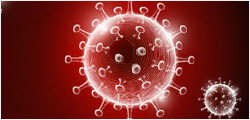The nonstructural (NS) protein NS3/4A?protease?is a critical factor for hepatitis C virus (HCV) maturation that requires activation by?NS4A. Synthetic peptide mutants of?NS4A?were found to?inhibit?NS3 function. The bridging from peptide inhibitors to heterocyclic?peptidomimetics?of?NS4A?has not been considered in the literature and, therefore, we decided to explore this strategy for developing a?new?class of NS3 inhibitors. In this report, a structure-based design?approach?was used to convert the bound form of?NS4A?into 1H-imidazole-2,5-dicarboxamide derivatives as first generation?peptidomimetics. This scaffold mimics the buried amino acid sequence Ile-25` to Arg-28` at the core of?NS4A21`-3... More
The nonstructural (NS) protein NS3/4A?protease?is a critical factor for hepatitis C virus (HCV) maturation that requires activation by?NS4A. Synthetic peptide mutants of?NS4A?were found to?inhibit?NS3 function. The bridging from peptide inhibitors to heterocyclic?peptidomimetics?of?NS4A?has not been considered in the literature and, therefore, we decided to explore this strategy for developing a?new?class of NS3 inhibitors. In this report, a structure-based design?approach?was used to convert the bound form of?NS4A?into 1H-imidazole-2,5-dicarboxamide derivatives as first generation?peptidomimetics. This scaffold mimics the buried amino acid sequence Ile-25` to Arg-28` at the core of?NS4A21`-33`?needed to activate the NS3?protease. Some of the synthesized compounds (Coded MOC) were able to compete with and displace?NS4A21`-33`?for binding to NS3. For instance,?N5-(4-guanidinobutyl)-N2-(n-hexyl)-1H-imidazole-2,5-dicarboxamide (MOC-24) inhibited the binding of?NS4A21`-33`?with a competition half maximal inhibitory concentration (IC50) of 1.9 ± 0.12 μM in a fluorescence anisotropy assay and stabilized the denaturation of NS3 by increasing the aggregation temperature (40% compared to?NS4A21`-33`). MOC-24 also inhibited NS3?protease?activity in a fluorometric assay. Molecular dynamics simulations were conducted to rationalize the differences in structure-activity relationship (SAR) between the active MOC-24 and the inactive MOC-26. Our data show that MOC compounds are possibly the first examples of?NS4A?peptidomimetics?that have demonstrated promising activities against NS3 proteins.



































